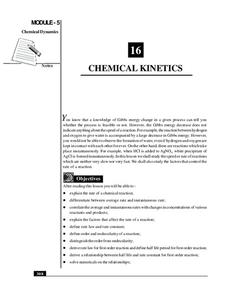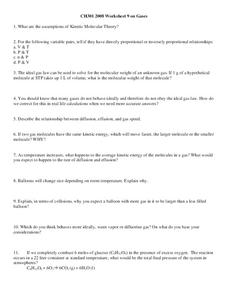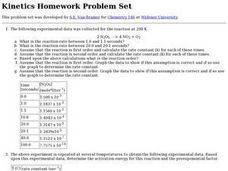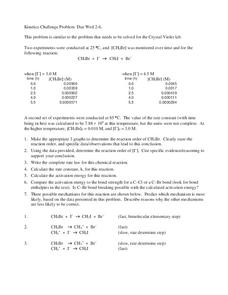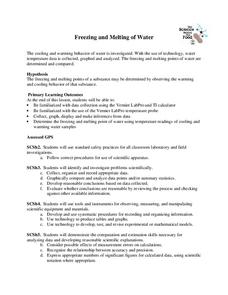National Institute of Open Schooling
Chemical Kinetics
Not all chemical reactions happen at the same rate because some, like explosions, occur quickly and some, like rusting, occur over time. Here, learners explore chemical reactions and their rates in the 16th lesson of 36. Through readings...
Pingry School
Kinetics of the Acid Decomposition of Thiosulfate
Several factors affect the rate of a chemical reaction including temperature, surface area, and concentration. Using an experimental approach, learners explore the effect concentration has on this rate while maintaining consistency with...
Curated OER
Gases
In this gases learning exercise, students review the kinetic molecular theory and use the ideal gas law to solve 20 problems.
Curated OER
Kinetics Homework Problem Set
In this chemistry worksheet, learners determine the reaction rate as specified for each in seconds. Then they determine the activation energy for the reaction and preexponential factor as stated. Students also determine the concentration...
Curated OER
A Potential Energy Worksheet
In this energy worksheet, students describe the differences between kinetic and potential energy and the difference between heat and temperature. This worksheet has 6 short answer questions.
Curated OER
Heating/Cooling Curve
In this heating and cooling curve activity, students use a given graph of a substance being heated from a solid to a liquid and then a gas over time. They use the graph to answer eleven questions about the phases of the substance and the...
Curated OER
Energy
Young scholars distinguish between kinetic an potential energy. They recognize that energy is conserved when changing from one form to another. Students compare the scientific meaning of work with its everyday meaning.
Curated OER
Transformations of Energy
Seventh graders investigate the relationship between energy and matter, and measure the mass of various objects. They listen to a teacher-led lecture about potential energy, and in small groups measure the mass of various objects such...
Curated OER
Balls and Ramp
Students role several balls of different weights down a ramp and into a paper cup and record how far each ball made the paper cup move. They then answer questions that help them analyze their results and reinforce the idea that energy...
CK-12 Foundation
Don't Slip
Salt is the go-to material when people need to melt ice—learn the chemistry behind its effectiveness with an interactive lesson. Pupils watch a short narrative and then explore the concept through a simulation. Young scientists...
Curated OER
Kinetics Worksheet
In this kinetics worksheet, students use concentration-time date tables to determine the rate of reaction and reaction order at each temperature. This worksheet has 4 problems to solve.
Curated OER
Kinetics Challenge Problem
In this kinetics worksheet, students use date from two experiments to determine the reaction order, calculate the rate constant and activation energy, and predict the mechanism for the reaction. This worksheet has 7 problems to solve.
Curated OER
Bounce!
Students investigate the relationship between potential and kinetic energy. In this energy lesson plan students investigate the height a ball will bounce when dropped from various heights.
Curated OER
Kinetics and Temperature
In this kinetics activity, students calculate the value of the activation energy for reactions at given rate constants. This activity has 5 problems to solve.
Curated OER
What is Temperature?
Students study the effects of temperature and air expansion. In this temperature lesson plan, students discuss temperature and participate in a role play of low energy and high energy molecules. Students then discuss their activity and...
Kenan Fellows
Sensors in Chemistry
The Environmental Protection Agency monitors sensors to track air pollution and set clean air standards. Enthusiastic young scientists use similar sensors to gather data in their area and then apply the gas laws and conservation of...
University of Georgia
Freezing and Melting of Water
Examine the behavior of energy as water freezes and melts. An engaging activity provides a hands-on experience to learners. Collaborative groups collect data and analyze the graphs of the temperature of water as it freezes and then...
Virginia Department of Education
The Rate of a Chemical Reaction
If your pupils think a catalyst is a list of their cats, then this might be the lesson for you! Young chemists study the effect of temperature, catalysts, concentration, and particle size on reaction rates during four different...
Curated OER
What is Temperature?
Students examine how temperature is the measure of the average kinetic energy of the molecules of a substance.
Curated OER
Absolute Zero Lab
In this absolute zero worksheet, learners experiment with a closed-end syringe and a ice bath and boiling water. They record volumes of gases in the syringe as well as temperatures of the water and they plot their experimental data. They...
Curated OER
The Speed of Chemistry
In this rates of chemical reactions worksheet, high schoolers read about the various factors that influence the rate of chemical reactions such as surface area, concentration, temperature and catalysts. Students answer eight questions...
Colorado State University
Why Can Warm Air "Hold" More Moisture than Cold Air?—Vapor Pressure Exercise
Does it feel a little humid in here? Learners assume the role of water vapor in the atmosphere as they explore the differences between warm and cold air. They roll dice to determine their level of energy, which determines if they stay...
Discovery Education
Cool It!
Adjust the melting time of ice without varying the temperature! Learners experiment with different materials to decide how the materials affect the rate an ice cube melts. They then connect their findings to the conductivity of each...
Curated OER
States of Matter
Students explore the states of matter. They discuss the different phrases of matter and categorize everyday substances as solids, liquids, or gases. Students explore the relationship between the phases on an atomic level and the role of...


